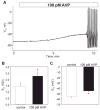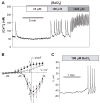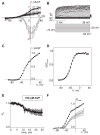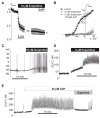Vasopressin stimulates action potential firing by protein kinase C-dependent inhibition of KCNQ5 in A7r5 rat aortic smooth muscle cells
- PMID: 17071736
- PMCID: PMC2577603
- DOI: 10.1152/ajpheart.00065.2006
Vasopressin stimulates action potential firing by protein kinase C-dependent inhibition of KCNQ5 in A7r5 rat aortic smooth muscle cells
Abstract
[Arg(8)]-vasopressin (AVP), at low concentrations (10-500 pM), stimulates oscillations in intracellular Ca(2+) concentration (Ca(2+) spikes) in A7r5 rat aortic smooth muscle cells. Our previous studies provided biochemical evidence that protein kinase C (PKC) activation and phosphorylation of voltage-sensitive K(+) (K(v)) channels are crucial steps in this process. In the present study, K(v) currents (I(Kv)) and membrane potential were measured using patch clamp techniques. Treatment of A7r5 cells with 100 pM AVP resulted in significant inhibition of I(Kv). This effect was associated with gradual membrane depolarization, increased membrane resistance, and action potential (AP) generation in the same cells. The AVP-sensitive I(Kv) was resistant to 4-aminopyridine, iberiotoxin, and glibenclamide but was fully inhibited by the selective KCNQ channel blockers linopirdine (10 microM) and XE-991 (10 microM) and enhanced by the KCNQ channel activator flupirtine (10 microM). BaCl(2) (100 microM) or linopirdine (5 microM) mimicked the effects of AVP on K(+) currents, AP generation, and Ca(2+) spiking. Expression of KCNQ5 was detected by RT-PCR in A7r5 cells and freshly isolated rat aortic smooth muscle. RNA interference directed toward KCNQ5 reduced KCNQ5 protein expression and resulted in a significant decrease in I(Kv) in A7r5 cells. I(Kv) was also inhibited in response to the PKC activator 4beta-phorbol 12-myristate 13-acetate (10 nM), and the inhibition of I(Kv) by AVP was prevented by the PKC inhibitor calphostin C (250 nM). These results suggest that the stimulation of Ca(2+) spiking by physiological concentrations of AVP involves PKC-dependent inhibition of KCNQ5 channels and increased AP firing in A7r5 cells.
Figures









Similar articles
-
Vascular KCNQ potassium channels as novel targets for the control of mesenteric artery constriction by vasopressin, based on studies in single cells, pressurized arteries, and in vivo measurements of mesenteric vascular resistance.J Pharmacol Exp Ther. 2008 May;325(2):475-83. doi: 10.1124/jpet.107.135764. Epub 2008 Feb 13. J Pharmacol Exp Ther. 2008. PMID: 18272810 Free PMC article.
-
Ca2+ signalling in rat vascular smooth muscle cells: a role for protein kinase C at physiological vasoconstrictor concentrations of vasopressin.J Physiol. 2000 May 1;524 Pt 3(Pt 3):821-31. doi: 10.1111/j.1469-7793.2000.00821.x. J Physiol. 2000. PMID: 10790161 Free PMC article.
-
Opposite regulation of KCNQ5 and TRPC6 channels contributes to vasopressin-stimulated calcium spiking responses in A7r5 vascular smooth muscle cells.Cell Calcium. 2009 Apr;45(4):400-11. doi: 10.1016/j.ceca.2009.01.004. Epub 2009 Feb 25. Cell Calcium. 2009. PMID: 19246091 Free PMC article.
-
Signal transduction of physiological concentrations of vasopressin in A7r5 vascular smooth muscle cells. A role for PYK2 and tyrosine phosphorylation of K+ channels in the stimulation of Ca2+ spiking.J Biol Chem. 2002 Mar 1;277(9):7298-307. doi: 10.1074/jbc.M104726200. Epub 2001 Dec 5. J Biol Chem. 2002. PMID: 11739373
-
Regulation of 4-aminopyridine-sensitive, delayed rectifier K+ channels in vascular smooth muscle by phosphorylation.Biochem Cell Biol. 1996;74(4):439-47. doi: 10.1139/o96-048. Biochem Cell Biol. 1996. PMID: 8960350 Review.
Cited by
-
Vascular KCNQ potassium channels as novel targets for the control of mesenteric artery constriction by vasopressin, based on studies in single cells, pressurized arteries, and in vivo measurements of mesenteric vascular resistance.J Pharmacol Exp Ther. 2008 May;325(2):475-83. doi: 10.1124/jpet.107.135764. Epub 2008 Feb 13. J Pharmacol Exp Ther. 2008. PMID: 18272810 Free PMC article.
-
The KCNE Tango - How KCNE1 Interacts with Kv7.1.Front Pharmacol. 2012 Aug 2;3:142. doi: 10.3389/fphar.2012.00142. eCollection 2012. Front Pharmacol. 2012. PMID: 22876232 Free PMC article.
-
New tricks for old dogs: KCNQ expression and role in smooth muscle.Br J Pharmacol. 2009 Apr;156(8):1196-203. doi: 10.1111/j.1476-5381.2009.00131.x. Br J Pharmacol. 2009. PMID: 19751313 Free PMC article. Review.
-
Kv7 potassium channels in airway smooth muscle cells: signal transduction intermediates and pharmacological targets for bronchodilator therapy.Am J Physiol Lung Cell Mol Physiol. 2012 Jan 1;302(1):L120-32. doi: 10.1152/ajplung.00194.2011. Epub 2011 Sep 30. Am J Physiol Lung Cell Mol Physiol. 2012. PMID: 21964407 Free PMC article.
-
Participation of KCNQ (Kv7) potassium channels in myogenic control of cerebral arterial diameter.J Physiol. 2010 Sep 1;588(Pt 17):3277-93. doi: 10.1113/jphysiol.2010.192823. Epub 2010 Jul 12. J Physiol. 2010. PMID: 20624791 Free PMC article.
References
-
- Byron KL, Lucchesi PA. Signal transduction of physiological concentrations of vasopressin in A7r5 vascular smooth muscle cells. J Biol Chem. 2002;277:7298–7307. - PubMed
-
- Byron KL, Villereal ML. Mitogen-induced [Ca2+]i changes in individual human fibroblasts. Image analysis reveals asynchronous responses which are characteristic for different mitogens. J Biol Chem. 1989;264:18234–18239. - PubMed
-
- Byron KL. Vasopressin stimulates Ca2+ spiking activity in A7r5 vascular smooth muscle cells via activation of phospholipase A2. Circ Res. 1996;78:813–820. - PubMed
Publication types
MeSH terms
Substances
Grants and funding
LinkOut - more resources
Full Text Sources
Other Literature Sources
Molecular Biology Databases
Miscellaneous

